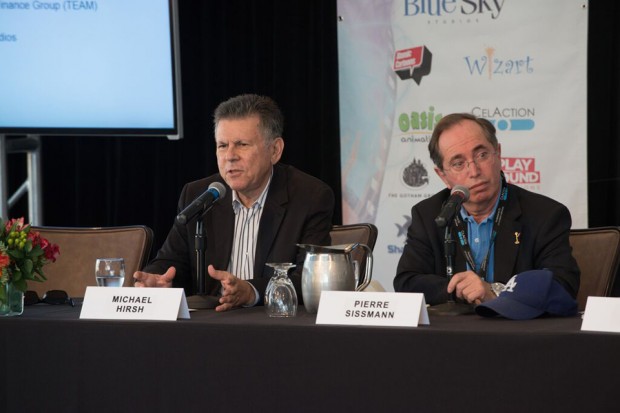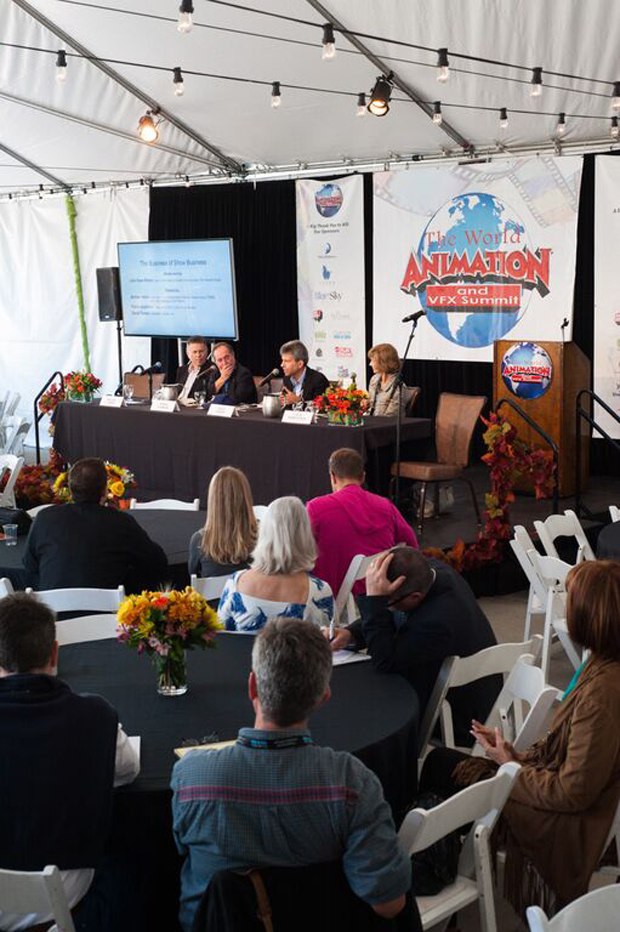The business model of entertainment has been disrupted, and studios and individuals are seeing that the old way of creating engaging content must change in order to attract the hearts and minds of a new generation.
Julie Kane-Ritsch, Head of Animation and Family Entertainment of The Gotham Group, moderated a panel of experts on this changing landscape at the World Animation and VFX Summit, which included Michael Hirsh, Chairman of the Entertainment and Media Finance Group (TEAM) and Vice Chairman of DHX Media; Pierre Sissmann, Chairman and CEO of Cyber Group Studios, and David Tenzer, Consultant and Founder of Tenzer Law.
There are a few constants to creating worthwhile programming in a new digital age, and that starts with hiring the right people.
“No matter where people come from you have to pick the right people for the job,” said Sissmann, former President of Disney Channel France and now Chairman and CEO of Cyber Group Studios.
Hirsh, co-founder of Nelvana and Cookie Jar and now Vice Chairman of DHX Media, agreed. “You want to hire the best people you can,” he said.
One issue that Tenzer, a former agent with Creative Artists Agency for 20 years, sees in the marketplace today is that everyone values mavericks, while few value the day in and day out willingness to get the job done.
“One of the more boring things we don’t talk about as much is the ability to be a member of the team as opposed to being a cowboy or a cowgirl and going off on your own,” said Tenzer. “That’s a valued skill.”
The group also discussed the changing landscape of entertainment and how digital content is disrupting the traditional television viewing experience.
“TV viewing is changing dramatically,” said Hirsh. “The chance that any kid will be watching something on TV in the next few years is slim. If you look at how many kids are watching YouTube, it’s enormous.”
The advantage to the rise of YouTube, Hulu, Amazon and Netflix is that creators now have the ability to create whatever type of content they want without gatekeepers at the traditional networks telling them what to do.
“If you can make the content less expensive you don’t have to go to a major studio,” said Tenzer. “You can go to a few financiers or use one or two credit cards. It creates freedom and choices and opportunities at every step of the way.”
All of the panelists agreed that this levels the playing field for those who traditionally were not able to be heard in the marketplace.
“It’s creating new opportunities for artists to be more entrepreneurial.” said Tenzer.
“The whole business has changed from being tightly curated to now anyone of us can decide what we want to make. You can reach more eyeballs through YouTube than Cartoon Network or Disney,” said Hirsh.
The downside to the multiplicity of outlets is that, sometimes, creators sacrifice solid storytelling for fancy technology, and it is more difficult to get a mass audience to pay attention to what you want to say.
“In a world where there are a million websites and 500 channels how do you get people to pay attention to your product?” said Tenzer. “The good news is there’s social media. That’s great in theory, but you still have to get people to pay attention.”
All of the panelists agreed that there is no easy solution to getting social media to work for you, or to get people to find your material. But that problem is preferable, they agreed, to the old obstacle course of trying to get through the network television model of creating programming.
“I would rather get the thing made and distributed and worry about marketing than worry about the lower level executive that can prevent your property from being made,” said Tenzer.






 Win a Funko X Lilo & Stitch Prize Pack!
Win a Funko X Lilo & Stitch Prize Pack! 
